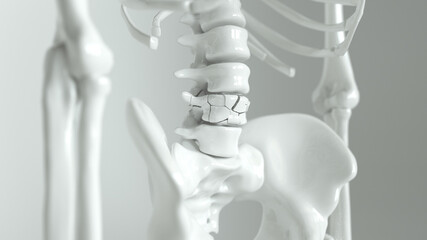The spine is an important component of our body since it bears the weight of our whole body and protects the spinal cord. Accidental injuries, including car accidents or falls, as well as underlying medical disorders like osteoporosis, may all contribute to the development of spinal fractures. That said, a fracture of the spine is a potentially life-threatening injury that needs immediate medical treatment. In this article, we will discuss the many kinds of spinal fractures as well as the various therapies available for them.
Compression Fractures
Compression fractures are the most frequent form of spinal fracture, especially in older persons who have osteoporosis. These fractures develop as a result of the vertebrae collapsing or compressing as a result of stress, injury, or trauma.
Extreme back discomfort, a loss of height, and a curvature of the spine are all symptoms that may be caused by compression fractures. Compression fractures may sometimes heal on their own if the patient gets enough rest, takes pain medication, and participates in physical therapy. On the other hand, if the fracture is very serious, surgery can be required.
Burst Fractures
Burst fractures are caused when the vertebrae split into multiple little fragments, which results in excruciating pain and damage to the nerves. These kinds of fractures are often the result of high-impact trauma, such as a vehicle accident, a fall from a height, or an injury sustained while playing sports. In the event of a burst fracture, rapid medical treatment is required, and in many cases, surgery is necessary to restore the injured vertebrae.
Flexion-Distraction Fractures
Flexion-Distraction fractures are sometimes referred to as “seat-belt fractures” because they are most frequently seen in individuals who have been engaged in automobile accidents while wearing seat belts. These fractures take place when there is a rapid forward or backward bending of the spine, which causes the vertebrae to break apart and cause the fracture.
Fractures that involve flexion and distraction have the potential to cause extensive damage to the spinal cord and need prompt medical treatment. Surgical procedures are often necessary for treatment in order to stabilize the spine and avoid future damage.
Fracture-Dislocation
A fracture-dislocation is a severe form of spinal fracture that takes place when the vertebrae become displaced from their usual position. Fracture-dislocations are the most common type of severe spinal fracture in both men and women. These fractures often cause serious injury to the spinal cord and need emergency medical intervention as soon as possible. Surgery is often required as part of the treatment plan in order to straighten the vertebrae and stabilize the spine.
Chance Fractures
Chance fractures take place when the spine is twisted forward and compressed, most commonly as the result of a fall or an automobile accident. These fractures may cause serious damage to the spinal cord; therefore, you should seek medical assistance as soon as possible if you sustain one of them. Surgery is the normal treatment for this condition since it is necessary to straighten the vertebrae and stabilize the spine as well.
Pathologic Fractures
When the vertebrae shatter due to an underlying medical condition such as osteoporosis, cancer, or infection, this may result in a pathologic fracture. These fractures may take place with little to no external force being applied and can result in considerable discomfort as well as a loss of height. The treatment of a fracture often includes the management of the underlying problem in addition to the treatment of the fracture itself with rest, pain medication, and physical therapy. Surgical intervention could be required in some circumstances.
Why Is It Important to Take Proper Care of Your Spinal Fractures?
Spinal fractures may cause extreme pain as well as incapacity, both of which can have a negative impact on an individual’s quality of life. You should seek medical assistance as soon as possible if you develop any symptoms, including discomfort in the back, a loss of height, or trouble walking. The treatment options for a spinal fracture vary according to the nature and severity of the break and may include bed rest, medication to manage pain, physical therapy, or even surgery. The quick identification and adequate care of the injury are essential components of a therapy plan in order to ensure that you recover properly and that the condition doesn’t worsen as you age.
Learn More About the Different Types of Spinal Fractures with Our Elite Spine Health & Wellness Experts
If you or someone you know may have undergone a spinal fracture and are looking to learn more about your treatment options, please give our medical experts a call, and we will get you started on your very own treatment as soon as possible.


